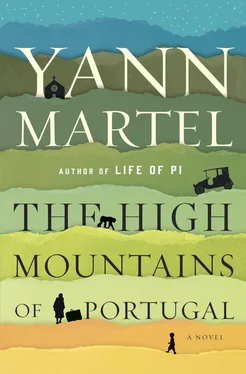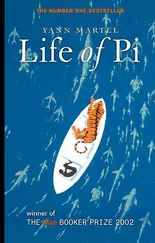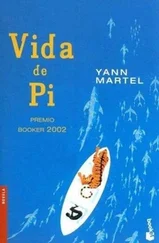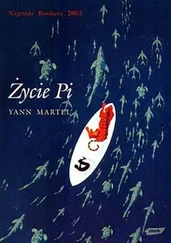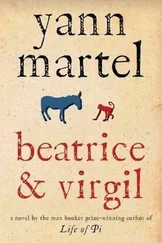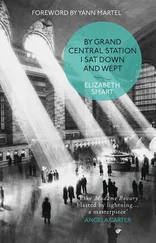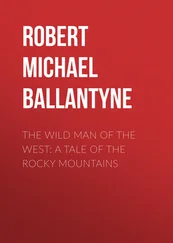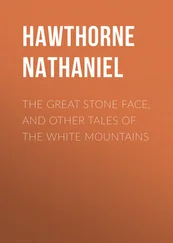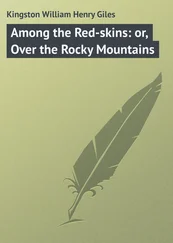“I knew who the man was. He had stopped to visit the church. A strange city man, quite filthy and sick. Father Abrahan spoke with him, then he ran off. He left behind the device he’d come on — an automobile, the first one we’d ever seen. It must have been an arduous journey back, all the way to wherever he came from. His automobile stayed in the square for weeks, we didn’t know what to do with it. Then one day a different man — a tall, thin one — walked into the village and drove it away without a word of explanation. People talked about the device and its driver, back and forth, back and forth. Was he just a visitor — or an angel of death? Whatever he was, I didn’t care. I had turned to remembering. We never had much use for memory before. Why remember him when you have him right there in front of your eyes? Memory was just an occasional pleasure. Then it’s all you’re left with. You try your best to live in your memories of him. You try to turn memories into real things. You pull the strings of a puppet and you say, ‘There, there, you see— he’s alive! ’
“It was Rafael who started calling him our bear cub after he died. Rafael said he was hibernating. ‘Eventually he’ll stir and wake, he’ll be ravenously hungry,’ he would say with a smile, attaching a fact — our son’s good appetite after a nap — to a fancy, that he was coming back. I played along: It was my comfort too.
“He was such a joy. Everyone said that. Unplanned, unexpected — I thought I was long past my child-bearing years, such as they had been — and suddenly he came along. We used to look at him and ask ourselves, ‘What child is this? Where did he come from?’ We both have dark eyes and dark hair — doesn’t everyone in Portugal? Yet his hair was as fair as a wheat field, and such eyes he had — bright blue. How did those eyes get into his head? Did a puff of the Atlantic blow into Tuizelo on the day he was conceived and add itself to his making? My theory is that the supplies in the pantry of our family tree were so rarely dipped into that when they finally were, only the best ingredients were used. He invented laughter. His joy-making was endless and his goodwill without limits. The whole village loved him. Everyone sought his attention and his affection, the adults and the other children. So much love was poured into those blue eyes. He took that love and gave it back, as happy and generous as a cloud.
“Rafael had gone down to help a friend near Cova da Lua. A week’s work, small money. He took him, our five-year-old boy. It would be an adventure for him. And he could help. Then it happened, while Rafael was sharpening the scythes on the whetstone. He paused and listened. It was too quiet. He called out. He searched around the farm. He searched in ever greater circles. Eventually he went along the road, calling out his name. That’s where he found him. What about the other foot?”
The question comes unexpectedly. Eusebio looks at the body’s left foot. He nicks it at the heel. Again vomit comes out.
“And higher up?” asks Maria Castro.
He does not hesitate now. With the scalpel he cuts into the right leg next to the tibia, midway up; into the left knee, between the patella and the medial condyle of the femur; into the thighs, a cut into each quadriceps. Each cut is about five or six centimetres long, and each time vomit oozes out, although he notes that it comes out with less pressure from the cuts on the thighs. He cuts across the pelvic girdle, just above the pubic mound, a long cut. He pulls the skin back. A bulk of vomit shows. Atop it, on its edge, the scalpel touches something hard but loose. He probes. There is a glimmer. He dislodges it and turns it with the blade. A coin — a five-escudo silver coin. There are other coins next to it, some escudos, the others centavos, each lying flat atop the vomit. A peasant’s meagre wealth.
He pauses. He wonders whether he should leave the coins there or extract them.
Maria Castro interrupts his thoughts. “The penis,” she says.
He takes hold of Rafael Castro’s sizable penis. At a glance, the shaft and the glans appear perfectly normal. No signs of Peyronie’s disease, no condylomata, no bowenoid papulosis. He decides to cut along a corpus cavernosum, one of the two spongy, elongated chambers that, when filled with blood, were the source of such pleasure for the couple. He slices the length of the penis, through the foreskin and into the glans. Again the scalpel strikes something hard where there should be nothing hard. He puts the blade down. With his thumbs on either side of the cut, and pushing on the opposite side of the penis with his fingers, he easily pushes out the hardness. It comes out in two pieces: wooden, smooth, round, and with holes.
“Oh!” says Maria Castro. “His sweet flute.”
The two other pieces of the peasant flute lie in the second corpus cavernosum. Because he is a man of order and method, Eusebio assembles the instrument. He passes it to the old woman, who brings it to her lips. A three-note trill floats in the air.
“He played it so nicely. It was like having a canary bird in the house,” she says.
She places it on the autopsy table, next to the body.
With a word here, a shake of the head there, displaying a perfect knowledge of Rafael Castro’s experiential anatomy, Maria Castro directs Eusebio’s scalpel. It is the simplest autopsy he has ever performed, requiring only that single sharp instrument, even for the head. She avoids the thorax and abdomen until the very end, preferring the distal discoveries of the upper limbs and of the neck and head.
The ring finger of the left hand is lightly packed with down feathers, as is the right hand’s middle finger, while in the index fingers of both hands he finds blood, fresh, red blood — the only trace of blood he finds anywhere in the body. All the other digits contain mud. The palm of the right hand holds an oyster shell, the palm of the left, pages from a small wall calendar. The arms are crowded. From them he extracts a hammer, a pair of tongs, a long knife; an apple; a clump of mud; a sheaf of wheat; three eggs; a salted cod; a knife and fork. Rafael Castro’s head proves roomier. Inside it he finds a square of red cloth; a small handmade wooden toy of a horse and cart with wheels that turn; a pocket mirror; more down feathers; a small wooden painted object, ochre in colour, that Maria Castro cannot identify; a candle; a long lock of dark hair; and three playing cards. In each eye he discovers a die, and a dried flower petal in place of the retina. The neck contains three chicken feet and what looks like kindling: dried leaves and twigs. The tongue holds ash except at its tip, where there is honey.
Lastly comes the thorax and abdomen. The old wife nods, though with evident trepidation this time. Eusebio ends the autopsy with the cut with which he expected to start it, the Y-shaped incision from the shoulders to the sternum down over the abdomen. He sections the skin as lightly as he can, barely slicing through the subcutaneous fat. Since he made a cut along the pelvic girdle earlier, the thoracic and abdominal cavities open up plainly to view.
He hears her gasp.
Though he’s no expert on the matter, he is quite certain that it is a chimpanzee, a kind of African primate. It takes him a little longer to identify the second, smaller creature, partly hidden as it is.
Filling Rafael Castro’s chest and abdomen, lying compactly in peaceful repose, are a chimpanzee and, wrapped in this chimpanzee’s protective arms, a bear cub, small and brown.
Maria Castro leans forward and presses her face to the bear cub. Is this then how her husband lived ? Eusebio says nothing, only watches. He notices the chimpanzee’s bright, clear face and thick, glossy coat. A young one, he concludes.
Читать дальше
